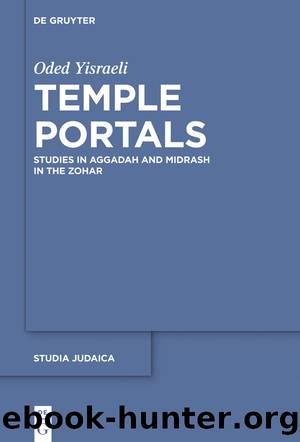Temple Portals by Oded Yisraeli

Author:Oded Yisraeli
Language: eng
Format: epub
Publisher: Walter de Gruyter
Published: 2016-02-15T00:00:00+00:00
Mosesâ hands and Amalekâs defeat
The Zoharâs attempt to avoid any magical dimensions in the story of the war against Amalekâthe virtually âofficialâ medieval kabbalistic interpretation of the textâis reflected in its understanding of the technique Moses used to win the battle, which deviates from the exegesis found in Sefer Habahir. As we observed above, whether citing it explicitly or not the thirteenth-century kabbalists generally adopted a thaumaturgical approach to the âBahiranâ homily that holds that Mosesâ ten fingers united the ten sefirot, drawing their influence over Israel and thus giving them the victory. Thus, for example, we find the following account in Rabbeinu Bachyaâs commentary on Exod 17:12
A kabbalistic approach: Mosesâ raising of his hands was a matter of his concentrating on his ten fingers being pointed at what is called ר×× ×ש×××, â the heights of the Heavensâ ⦠He did something similar to what the priests do when they raise their hands in the priestly blessing. By concentrating on the number ten, they also concentrate on the ten emanations and the source of blessing that flows from that region to disembodied spirits. At such a time the power of any force opposing such prayers is checked and its influence halted (at least temporarily). At such moments the Israelite soldiers would be victorious. The words ×××ר ×שר××, â Israel had the âupperâ hand,â was therefore something closely linked to Mosesâ continued ability or willingness to raise his fingers and concentrate on the number ten. Whenever Mosesâ concentration flagged, the accusing finger of the celestial representative of Amalek made itself felt and the Israelites retreated. (1998: 3:1015)
Bachya understands Mosesâ raised hands as drawing power and bringing down the upper forces in order to strengthen Israel in the war against Amalek. We find a similar thought in other kabbalists belonging to the âzoharic circleâ or influenced by it, as well as other kabbalistic groups.310 Like Rabbeinu Bachya, these suggest a link between Mosesâ raised hands and the priestly blessing. Discussing this issue at length, Pedaya (2005: 116â120) has drawn attention to its diverse implications in kabbalistic works, beginning with Sefer Habahir itself.311
The zoharic homily offers a very different tradition, asserting that the war took place in the upper realms between âIsrael aboveâ and âsevere Judgmentââi.e., the sefira of Gevura. The power of Judgment increasing because of Israelâs sins, the fragile balance within the sefiric realm is upset, threatening its unity. Mosesâ raised hands are thus meant to restore sefiric harmony by reinforcing the attribute of Hesed over that of Din, his higher right hand seeking to makeâHesedâprevail over the left-hand side of the godhead (i.e., Gevura). This technique differs significantly from that depicted in Sefer Habahir. The Zohar also associates Mosesâ action with the priestly raising of hands, adducing the biblical description of Aaronâs blessing in several places: âAaron lifted his hands toward the people and blessed them; and he came down after sacrificing the sin offering, the burnt offering, and the offering of well-beingâ (Lev 9:22).312 As in the case
Download
This site does not store any files on its server. We only index and link to content provided by other sites. Please contact the content providers to delete copyright contents if any and email us, we'll remove relevant links or contents immediately.
| Hebrew Bible (Old Testament) | Talmud |
| Torah | Zohar |
The Secret Power of Speaking God's Word by Joyce Meyer(2264)
Man's Search for Meaning by Viktor E. Frankl(2264)
Mckeown, Greg - Essentialism: The Disciplined Pursuit of Less by Mckeown Greg(2117)
MOSES THE EGYPTIAN by Jan Assmann(1981)
Unbound by Arlene Stein(1946)
Devil, The by Almond Philip C(1910)
The Complete Dead Sea Scrolls in English (7th Edition) (Penguin Classics) by Geza Vermes(1852)
I Capture the Castle by Dodie Smith(1580)
Schindler's Ark by Thomas Keneally(1517)
The Invisible Wall by Harry Bernstein(1464)
The Gnostic Gospel of St. Thomas by Tau Malachi(1417)
The Bible Doesn't Say That by Dr. Joel M. Hoffman(1376)
The Secret Doctrine of the Kabbalah by Leonora Leet(1273)
The Jewish State by Theodor Herzl(1256)
The Book of Separation by Tova Mirvis(1227)
A History of the Jews by Max I. Dimont(1212)
The Dead Sea Scrolls Bible by Martin G. Abegg(1207)
Political Theology by Carl Schmitt(1190)
Oy!: The Ultimate Book of Jewish Jokes by David Minkoff(1107)
